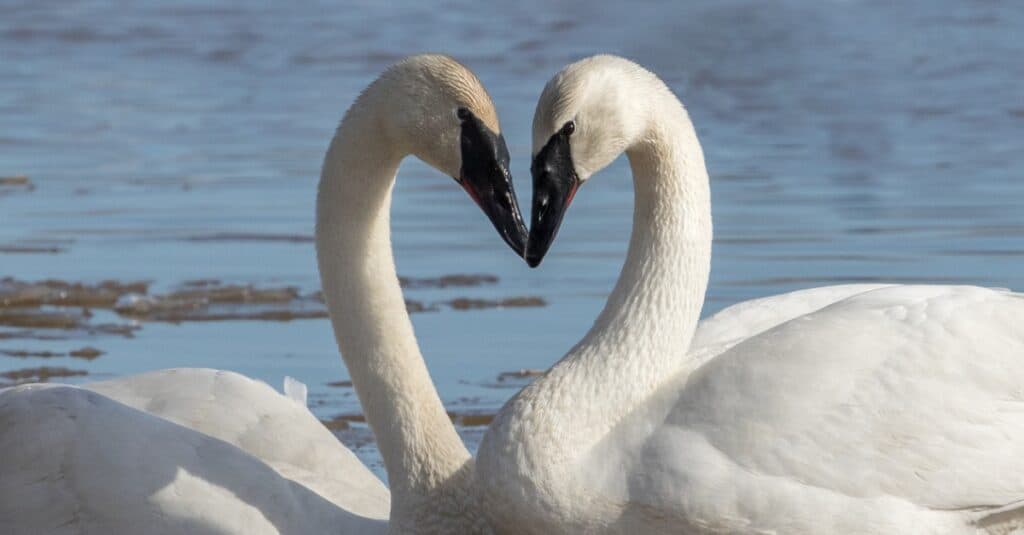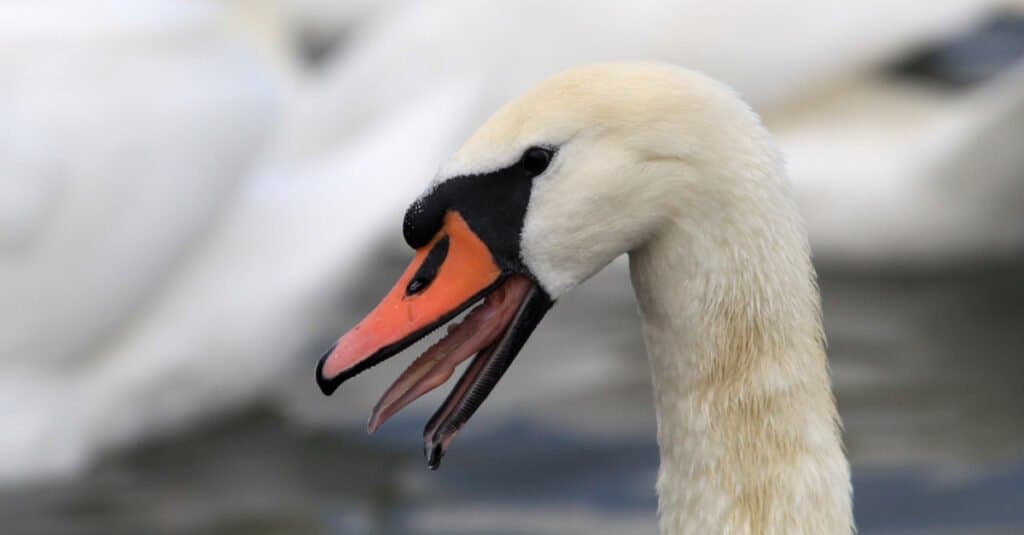Swans may be one of the most beautiful birds one can imagine. They are covered in shiny white feathers, and float ever so gracefully above the water. Around the world, swans are well-recognized for their beauty and magnificence, especially when a wedge of them flock together to form a stunning view.
Apart from their undeniable beauty, swans are also well-known for being romantics. Swans, unlike most animals and birds, mate for life and raise a family of cygnets together.
Given their wondrous physical appearance and a prim, majestic, and graceful reputation, it might be hard to assume that swans feed not only on plants and vegetation. While swans love to eat leafy greens, algae, grass, and aquatic plants, they also feast on insects, worms, freshwater shrimp, snails, and sometimes on frogs and even molluscs. Swans might be a symbol of love and romance for many, but these birds can also be pretty aggressive, especially when they are defending their young. This begs the question, “do swans have teeth?”
Do Swans Have Teeth?

Like all birds, swans do not have teeth, but have strong beaks which they use in pecking their food.
©iStock.com/Dee Carpenter Photography
The quick answer here is no. Swans, like all birds, do not have conventional teeth, but rather strong beaks that helps them peck and swallow their food. However, swans’ beaks have edges that are serrated, giving the illusion that swans have teeth.
Most people think swans have teeth, and it is understandable. Swans are large aquatic birds that belong to the Anatidae family, which includes ducks and geese, and thus have beaks. Swans’ beaks, however, have serrated edges that are somehow similar to the appearance of tiny jagged teeth. These serrated edges are used to catch fish and frogs, as well as algae and other slippery aquatic organisms.
What Does a Swan Beak Look Like?

A thin layer of membrane, known as a lamellae, lines the edges of a swan’s “teeth”.
©Tone Trebar/Shutterstock.com
A swan’s beak has a so-called lamellae, a thin layer of membrane that lines the edges of the beak, making it look like the beak is lined with small, pointy teeth.
One way that Anatidae species’ “teeth” vary from humans or other mammals’ teeth is that they lack a protective coating known as enamel. They, however, are made of cartilage, the very same tissue that connects human nose and ears, but it does not mean they are soft and flexible.
How Do Swan Beaks Work?
The swan’s lamellae functions the same way teeth function for other animals. They are used to cut leafy vegetables and to pierce through flesh of other small vertebrates and invertebrates going through their mouth.
A swan’s beak has customized parts and structure to help them adapt to various feeding situations. Swans are generally herbivores, but they also eat small insects and amphibians, or even worms, so they need a dental structure that can fit their diet and will help them easily navigate their feeding.
When food is filtered or strained via the swan’s lamellae, it is possible to remove soil and water from it, thus filtering the mud with whatever food they can get from it. Moreover, the swan’s lamellae, as surprising as it may be, is actually made from the beak.
Parts of a Swan’s Beak

Swan beaks help break down down their food.
©Ihi/Shutterstock.com
A swan’s beak is made up of a basal knob, the swan’s nares, upper and lower mandibles, a thin, keratinized layer, a serrated, comb-like lamellae, and a nail.
The swan’s beak is long and flattened. Unlike teeth, their beaks do not have enough strength and sharpness to grind extremely hard food. Because they lack teeth, swans rely on the structure of their beak, which is spatulate, to help them break down their food.
A swan’s beak has a little hump on its end if you look closely, which may differ in shape and color from the beak’s overall hue.
Swans have nails, which are different to the nails we have. They are the rigid, swollen portion of the swan’s beak that are used to forage and dig through mud to find small seeds, worms and roots, as well as other nourishment.
Do Swans Have Teeth in their Tongues?
If you look closely at an open mouth of a swan, you’ll notice that their tongues have the same serrations as they have on their beaks. These jagged edges are not teeth, but are also lamellae.
Swans’ tongues have lamellae on each side, a distinctive dental structure which they often use to help them dig up plants and hold small prey in their mouth.
Because their tongues have serrated edges, swans can easily remove plants from the ground. With their beaks and tongues, swans are able to hold the grass in place while they uproot it from the ground.
Small prey like mice and insects can also be held inside their mouths by their jagged tongue. With spikes protruding through their bodies, these creatures have less of a chance of escaping. Despite the fact that the lamellae aren’t actually teeth, they’re nonetheless capable of doing a lot of harm to their victim when they attack.
How Do Swans Digest Their Food?
In terms of eating and digestion, swans have gizzard instead of teeth. Parallel to a mammal’s cheek teeth or set of molars and premolars, the gizzard in swans and most birds is primarily just a muscular organ that helps chew food.
The gizzard may sound like it is just another organ, but it is a tough and powerful one. The gizzard of the swan is used to crush food so that it can be easily digested. When a swan is fed a hard grain like wheat, it must be crushed into a pulp first before the swan can properly digest it. The swan’s gizzard is quite critical in the swan’s digestion process.
When the swan is eating, it also takes in some little pieces of grit. The swan’s gizzard develops these particles over time, which also aids in the chewing process.
The photo featured at the top of this post is © iStock.com/Dee Carpenter Photography
Thank you for reading! Have some feedback for us? Contact the AZ Animals editorial team.






